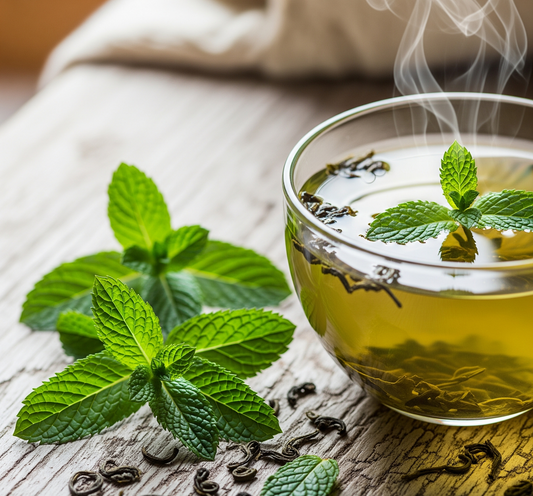In this blog we will focus specifically on how black teas are made and even within black teas, two special teas that we produce namely, Kanchanjangha Noir and Kumari Gold. The black tea making process follows quite a scientific step-by-step process that is combined with the “art” aspect of the tea maker. Therefore, we tend to call the tea making process a combination of art and science.
Go to comments (2)Black tea is the most common tea that is consumed throughout the world. In terms of numbers, black tea accounts for more than 68% of total tea consumption in the world and more than 80% of consumption in the US alone according to the Tea Association of the USA. So, it's normal to wonder "how is black tea made?"
The world of tea has evolved tremendously. While we now hear about different kinds of teas more than ever, it is essential to understand that every single tea in the world comes from the same plant; Camellia Sinensis. What differentiates various teas into categories like white, green, oolong, black, and Pu-erh is primarily the oxidation process.
The Rise of Tea: From Everyday Brew to Premium Experience
The tea industry has undergone a transformation similar to that of wine. Decades ago, people merely ordered red or white wine without much thought about its nuances. Over time, wine enthusiasts have become more discerning, preferring Pinot Noir, Cabernet Sauvignon, or a 1985 Stag's Leap Cabernet Sauvignon Cask 23. A similar trend is happening in tea, where people now appreciate distinctions between green, black, oolong, white, and Pu-erh. The rise of premiumization means that tea lovers are not just paying for a higher price tag; they are valuing the craftsmanship, unique flavor profiles, and the exclusivity of rare teas. This shift in perception has led many to refer to tea as the new wine.
How is Black Tea Made?
Black tea is one of the most consumed types of tea globally. But how is black tea made? The black tea production process is both a scientific and artistic endeavor, combining precise steps with the expertise of skilled tea makers. Below, we’ll explore the step-by-step process of black tea production and highlight two special teas produced at Nepal Tea Collective; Himalayan Sunrise and Kumari Gold.
 In this blog we will focus specifically on how black teas are made and even within black teas, two special teas that we produce namely, Himalayan Sunrise and Kumari Gold. The black tea making process follows quite a scientific step-by-step process that is combined with the “art” aspect of the tea maker. Therefore, we tend to call the tea making process a combination of art and science.
In this blog we will focus specifically on how black teas are made and even within black teas, two special teas that we produce namely, Himalayan Sunrise and Kumari Gold. The black tea making process follows quite a scientific step-by-step process that is combined with the “art” aspect of the tea maker. Therefore, we tend to call the tea making process a combination of art and science.
Plucking: The First Step in Black Tea Production
Generally, two leaves and a bud are plucked during the summer season from every bush in an interval of 7 days. During the summer, with the right amount of heat and rainfall, the tea bushes are at their peak maturity and that is the busiest time in tea production.
Our special Kumari Gold black tea, often known as golden tips tea, has quite a bit of unique tweaks to the normal black tea processing technique. Similar to other specialty teas, generally only one leaves and the terminal bud are carefully plucked during the second flush (summer season). This is one of the biggest distinctions between a normal black tea and our special golden tips.
What is the best season for plucking black tea leaves?
Quick Answer: The best season for plucking black tea leaves is during the summer (second flush) when the tea bushes have reached peak maturity and produce leaves with optimal flavor and aroma.
Withering: Reducing Moisture Content
The freshly hand-plucked delicate leaves are withered to get the moisture out of the tea leaves so that the leaves remain intact during the rolling process. The leaves are withered in withering troughs for several hours, sometimes even overnight depending on the type of leaves and the season.
With the majority of the water evaporated, the rubbery leaves are then placed on a rolling machine. The withering process is mainly done to lose the water content in tea. After the desirable loss of moisture is attained, the tea makers transfer the wilted leaves to the rolling machine.
Rolling: Unlocking the Essential Oils
The rolling process is one of the most important steps in the black tea making process. With utmost care, the leaves are rolled by machines that rotate in a circular motion and the applied pressure is controlled and changed throughout the rolling process. While our classic black tea is rolled for half an hour, the Kumari Gold is only rolled for about 20 mins at varying pressure.
The rolling process bruises the tea leaves and breaks the cell walls that allows the essential oils and other enzymes to be released and react with oxygen. This process is significantly important in bringing out the final flavor profiles and aroma of the tea.

Oxidation: The Key to Black Tea’s Flavor and Color
What is oxidation in black tea?
Quick Answer: Oxidation is a natural process where enzymes in tea leaves react with oxygen, changing the color of the leaves from green to dark brown and developing rich flavors.
Oxidation is nothing more than enzymes reacting with oxygen in the air. Everyone of you here has definitely seen how a half-bitten apple turns brown within a short period of time. That is the exact process we let happen with the rolled teas. The bruised teas are layered into oxidizing trays or just on marble floors to sit there and just react with oxygen.
 This is the period of time, the tea leaves go through a visible change in color from pale green to dark rich brown. It is also during this time that the tea leaves develop the strong aroma of roasted nuts, caramel and/or dark chocolate.
This is the period of time, the tea leaves go through a visible change in color from pale green to dark rich brown. It is also during this time that the tea leaves develop the strong aroma of roasted nuts, caramel and/or dark chocolate.
During the oxidation process; especially for our Golden Tips tea; Kumari Gold, the leaves are turned and set in many different positions in frequent intervals. This is not only critical in bringing out the desired flavors, but it also enhances the golden coloring of the buds through oxidation.
Drying: Locking in the Aromas
After sufficient oxidation, depending on the type of black tea being produced, the tea is then dried in a commercial dryer. This process stops the oxidation process completely and also locks in the aromatics developed during the peak of the oxidation process. This drying process basically completes the production process for the black tea and the final teas that come out of the dryer are known as The DMT (Dryer Mouth Tea).

Sorting: The Final Step Before Packaging
Many teas are sold as DMT (Dryer Mouth Tea) without any sorting but our Kanchanjangha Noir goes through many other sorting and grading processes. The DMT is placed though several tea sorting machines that result in different grades of teas such as SFTGFOP1, TGBOP, GOF and so on. After machine sorting, the teas also go through a manual hand-sorting before being packed and sent to our customers.
What are tea grades?
Quick Answer: Tea grades categorize tea leaves based on size, shape, and quality, with higher grades typically consisting of whole leaves and buds.

Conclusion: The Art and Science of Black Tea Production
Black tea production is both a scientific process and an artistic craft. From plucking the delicate leaves to controlling oxidation, every step influences the final flavor, aroma, and quality of the tea.
At Nepal Tea Collective, we take immense pride in crafting specialty black teas like Kanchanjangha Noir and Kumari Gold. These teas are not just beverages; they are the result of centuries-old techniques, expert craftsmanship, and a deep respect for nature.
Whether you are a tea connoisseur or just starting your journey into premium teas, understanding how black tea is made enhances your appreciation for every sip.
Frequently Asked Questions (FAQs)
What is the difference between black tea and green tea?
The key difference lies in oxidation. Black tea is fully oxidized, giving it a bold, malty flavor, while green tea is minimally oxidized, resulting in a fresh, grassy taste.
Does black tea have more caffeine than green tea?
Yes, black tea generally has more caffeine than green tea but less than coffee. However, caffeine content varies based on the tea variety and brewing method.
What gives black tea its dark color?
The oxidation process turns the tea leaves from green to dark brown, enhancing both color and flavor.
What is the best way to brew black tea?
Use boiling water (around 200°F or 93°C) and steep for 3–5 minutes, adjusting based on personal taste preferences.
What are the health benefits of black tea?
Black tea is rich in antioxidants and may help improve heart health, boost energy, and support digestion.
What is oxidation in black tea?
Oxidation is a natural process where enzymes in tea leaves react with oxygen, changing the color of the leaves from green to dark brown and developing rich flavors.
About the Author
Nishchal Banskota is the founder of Nepal Tea Collective, dedicated to offering the finest Nepali teas. With years of experience in the tea industry, Nishchal is passionate about sharing the culture and craftsmanship of Nepali tea with the global tea industry. Learn more about Nepal Tea Collective and explore a variety of award-winning teas that bring you closer to the heart of Nepal.







How is black tea made: A Beginner's Guide to Black Tea Production
Comments (2)
Hi Doris,
I am so glad you found the process interesting and yes we will be explaining the overall process of whites and green and other teas in detail in the near future! Stay tuned!
Chees!
Nish
Thank you for explaining the process. It was very interesting to learn. Will you go on to explain the process for white, green, etc?